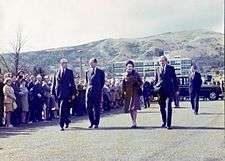Royal Signals and Radar Establishment
The Royal Signals and Radar Establishment (RSRE) was a scientific research establishment within the Ministry of Defence (MoD) of the United Kingdom. It was located primarily at Malvern in Worcestershire, England.[1]
History

RSRE was formed in 1976 by an amalgamation of previous research organizations; these included the Royal Radar Establishment (RRE), itself derived from the World War II-era Telecommunications Research Establishment.
The RSRE motto was Ubique Sentio (Latin for "I sense everywhere").
In 1979 it merged with the Services Electronic Research Laboratory (SERL) formerly at Baldock and the Signals Research and Development Establishment (SRDE) formerly at Christchurch.[2] There were out-stations at the ex-RAF airfields at Defford and Pershore. Another out-station was the satellite tracking station at Sheriffs Lench.
In April 1991 RSRE amalgamated with other defence research establishments to form the Defence Research Agency, which in April 1995 amalgamated with more organisations to form the Defence Evaluation and Research Agency. In June 2001 this became independent of the MoD, with approximately two-thirds of it being incorporated into QinetiQ, a commercial company owned by the MoD, and the remainder into the fully government-owned laboratory DSTL. In 2003 the Carlyle Group bought a private equity stake (~30%) in QinetiQ.
Research
Some of the most important technologies developed from work at RSRE are radar, thermography, liquid crystal displays, speech synthesis and the Touchscreen.
Contributions to computer science made by the RSRE included ALGOL 68RS (a portable implementation of ALGOL 68, following on from ALGOL 68R developed by RRE), Coral 66, radial basis function networks, hierarchical self-organising networks (deep autoencoders), the VIPER high-integrity microprocessor, the ELLA hardware description language, and the TenDRA C/C++ compiler.
RSRE was an early researcher of TCP/IP, along with Peter Kirstein's group at University College London. The first email sent by a head of state was sent from the RSRE over the ARPANET by Queen Elizabeth II on March 26, 1976.[3][4] RSRE was allocated class A Internet net 25 in 1979,[5] which later became the Ministry of Defence address space, providing 16.7 million IPv4 addresses.[6]
References
- Putley, E. H. (January 1985). "The history of the RSRE". Physics in Technology. 16 (1). doi:10.1088/0305-4624/16/1/401.
- Eds. Robert Bud and Philip Gummett, Cold War Hot Science: Applied Research in Britain's Defence Laboratories 1945-1990, Harwood, 1999 ISBN 90-5702-481-0
- Metz, Cade (25 December 2012). "How the Queen of England Beat Everyone to the Internet". Wired. ISSN 1059-1028. Retrieved 9 January 2020.
- Left, Sarah (13 March 2002). "Email timeline". The Guardian. ISSN 0261-3077. Retrieved 9 January 2020.
- Postel, J. (3 May 1979). "Assigned Numbers". USC - Information Sciences Institute. RFC755. Retrieved 6 April 2020.
- Study into UK IPv4 and IPv6 allocations (PDF). Reid Technical Facilities Management (Report). Ofcom. 2014. Ofcom/140701-00. Retrieved 6 April 2020.
External links
- Records of the Royal Signals and Radar Establishment, The National Archives, UK
- QinetiQ – the commercial successor of DERA and RSRE
- DSTL – the MOD owned successor of DERA and RSRE